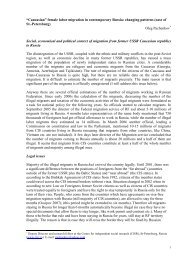THORIUM AS AN ENERGY SOURCE - Opportunities for Norway ...
THORIUM AS AN ENERGY SOURCE - Opportunities for Norway ...
THORIUM AS AN ENERGY SOURCE - Opportunities for Norway ...
You also want an ePaper? Increase the reach of your titles
YUMPU automatically turns print PDFs into web optimized ePapers that Google loves.
Non-proliferation<br />
Nations with secure nuclear capabilities (fuel cycle states) would provide fresh fuel and recover<br />
used fuel to nations that agree to use nuclear energy <strong>for</strong> peaceful purposes. If fast breeder<br />
reactors with a closed fuel cycle are developed and with natural uranium as a fuel, many of the<br />
perceived problems with present Light-Water Reactors can be avoided as far as proliferation is<br />
concerned. There has not been a single example of proliferation with Light Water Reactors. The<br />
elimination of uranium enrichment and recycled actinide (not pure Pu-239) fuel precludes<br />
unauthorized handling.<br />
The military development of bombs has been based on fissile U-235 and Pu-239. With an<br />
emerging civil nuclear energy technology based on thorium it could not be excluded that also<br />
uranium-233 (U-233) produced from thorium could be used <strong>for</strong> the weapons sector. The fissile<br />
weapons quality is evaluated in terms of:<br />
1. The critical mass of an isotope (or different isotopic composition),<br />
2. the weapon yield degradation due to the pre-initiation caused by spontaneous fission neutrons<br />
and<br />
3. the weapon stability degradation caused by heat emission.<br />
U-233 has been determined to be at least as efficient as U-235 as a weapon material, e.g. the<br />
critical mass of U-233 is approximately 5 - 8 kg (with neutron reflector) [48], [148] and U-233 has<br />
to be diluted by uranium-238 (U-238) below a level of 12 wt% in order to reach the proliferation<br />
limit [148].<br />
Reprocessing of thorium-based fuel yields almost pure U-233 and there<strong>for</strong>e weapon-grade<br />
material. E.g. <strong>for</strong> the equilibrium fuel cycle of a uranium-thorium fuelled light-water reactor the<br />
recycled uranium typically contains about 55 wt% U-233 and 10 wt% U-235, which is a fissile<br />
content sufficient <strong>for</strong> nuclear explosives [152]. However, traces of U-232 are always present in<br />
fissile U-233. In the reactor, thorium is irradiated by neutrons leading not only to the isotope U-<br />
233 but also to a minute fraction of U-232. The appearance of gamma emitting nuclides (e.g. Tl-<br />
208) in the decay chain after U-232 (life time 68.9 years) would make an extracted material<br />
highly radioactive. The contact dose rate of 30 kg of U-233, with the small content of U-232,<br />
would after a few years be about 72 Sv/hour, which corresponds to a 50 % lethal dose after 5<br />
minutes exposure to the bare mass [153]. The fractional quantity of U-232 depends on the<br />
neutron spectrum and on the burn-up and can reach 5000 ppm [148]. The presence of U-232 will<br />
thus create a radiation hazard which is sufficiently large to require remote handling within a<br />
short time after chemical separation. This problem rules out the military use of U-233 by the<br />
Nuclear Weapons States – they appear to have enough of the more conventional weapons<br />
material. On the other hand, terrorist groups or rogue states might want fissile material <strong>for</strong><br />
immediate use rather than <strong>for</strong> stockpiling. U-233 could be decontaminated from decay products<br />
<strong>for</strong> a few days [154] or even weeks [155] allowing the fabrication of a weapon.<br />
In conclusion, it seems that there is consensus amongst the experts that thorium based fuel cycles<br />
do not produce (weapon-grade) plutonium. However, the proliferation resistance of U-233 depends<br />
on the reactor and reprocessing technologies. The judgements range from that the risk of nuclear<br />
proliferation is “negligible” [156] to “very small (Radkowski LWR), medium (gas-cooled hightemperature<br />
reactor) or small (EA)” [157] and to statements that “U-233 requires the same level<br />
of safeguards oversight and physical protection as does plutonium” [154]. It is obvious that the<br />
thorium fuel cycle in general has advantages concerning the proliferation resistance, advantages<br />
that can be exploited in the design of a reactor technology and a fuel cycle merely <strong>for</strong> civil<br />
purposes and without connections to the military sector. However, due to the lack of experience<br />
with industrial-scale thorium fuel cycle facilities we adopt the view that similar safeguard<br />
measures as <strong>for</strong> plutonium are mandatory.<br />
93

















